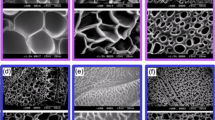Abstract
NaOH/urea aqueous solution is a novel, green solvent for cellulose. To explain why cellulose just be dissolved in this solvent under −13 °C, we studied and discussed the dissolving process of cellobiose in water, urea solution, NaOH solution and NaOH/urea aqueous solution. Dissolving cellobiose in water and the urea solution absorb heat, which is an entropy-driven process. Dissolving cellobiose in NaOH solution and mixed NaOH/urea solution is exothermic, which is an enthalpy-driven process. OH− plays an important role in the dissolving process by forming a hydrogen-bonding complex. From the thermodynamic point of view, negative entropy can well interpret why cellulose must be dissolved in cold NaOH/urea aqueous solution.



Similar content being viewed by others
References
Cai J, Zhang L, Liu S, Liu Y, Xu X, Chen X, Chu B, Guo X, Xu J, Cheng H, Han CC, Kuga S. Dynamic self-assembly induced rapid dissolution of cellulose at low temperatures. Macromolecules. 2008;41:9345–51.
Cai J, Zhang L. Unique gelation behavior of cellulose in NaOH/urea aqueous solution. Biomacromolecules. 2006;7:183–9.
Cai J, Zhang L, Zhou J, Qi H, Chen H, Kondo T, Chen X, Chu B. Multifilament fibers based on dissolution of cellulose in NaOH/urea aqueous solution: structure and properties. Adv Mater. 2007;19:821–5.
Qi H, Chang C, Zhang L. Properties and applications of biodegradable transparent and photoluminescent cellulose films prepared via a green process. Green Chem. 2009;11:177–84.
Luo X, Liu S, Zhou J, Zhang L. Properties of films composed of cellulose nanowhiskers and a cellulose matrix regenerated from alkali/urea solution. J Mater Chem. 2009;19:3538–45.
Chang C, Peng J, Zhang L, Pang D. Strongly fluorescent hydrogels with quantum dots embedded in cellulose matrices. J Mater Chem. 2009;19:7771–6.
Liu S, Zhang L, Zhou J, Xiang J, Sun J, Guan J. Fiberlike Fe2O3 macroporous nanomaterials fabricated by calcinating regenerate cellulose composite fibers. Chem Mater. 2008;20:3623–8.
Botti A, Bruni F, Imberti S, Ricci MA, Soper AK. Ions in water: the microscopic structure of concentrated NaOH solutions. J Chem Phys. 2004;120:10154–62.
Botti A, Bruni F, Imberti S, Ricci MA, Soper AK. Solvation shell of OH− ions in water. J Mol Liq. 2005;117:81–4.
Woutersen S, Emmerichs U, Bakker HJ. Femtosecond Mid-IR pump-probe spectroscopy of liquid water: evidence for a two-component structure. Science. 1997;278:658–60.
Bakker HJ, Nienhuys HK. Delocalization of protons in liquid water. Science. 2002;297:587–90.
Nienhuys HK, Lock AJ, Santen RA, Bakker HJ. Dynamics of water molecules in an alkaline environment. J Chem Phys. 2002;117:8021–9.
Omta AW, Kropman MF, Woutersen S, Bakker HJ. Negligible effect of ions on the hydrogen-bond structure in liquid water. Science. 2003;301:347–9.
Chen B, Ivanov I, Park JM, Parrinello M, Klein ML. Solvation structure and mobility mechanism of OH−: a Car–Parrinello molecular dynamics investigation of alkaline solutions. J Phys Chem B. 2002;106:12006–16.
Chen B, Park JM, Ivanov I, Tabacchi G, Klein ML, Parrinello M. First-principles study of aqueous hydroxide solutions. J Am Chem Soc. 2002;124:8534–5.
Tuckerman ME, Marx D, Parrinello M. The nature and transport mechanism of hydrated hydroxide ions in aqueous solution. Nature. 2002;417:925–9.
Ludwig R. New insight into the transport mechanism of hydrated hydroxide ions in water. Angew Chem Int Ed. 2003;42:258–60.
Ludwig R. Water: from clusters to the bulk. Angew Chem Int Ed. 2001;40:1808–27.
Frank HS, Franks F. Structural approach to the solvent power of water for hydrocarbons; urea as a structure breaker. J Chem Phys. 1968;48:4746.
Wetlaufer DB, Malik SK, Stoller L, Coffin RI. Nonpolar group participation in the denaturation of proteins by urea and guanidinium salts. Model compound studies. J Am Chem Soc. 1964;86:508–14.
Finer EG, Franks F, Tait MJ. Nuclear magnetic resonance studies of aqueous urea solutions. J Am Chem Soc. 1972;94:4424–9.
Adams R, Balyuzi HHM, Burge RE. X-ray diffraction studies of aqueous solutions of urea. Appl Crystallogr. 1977;10:256–8.
Hoccart X, Turrel G. Raman spectroscopic investigation of the dynamics of urea–water complexes. J Chem Phys. 1993;99:8498–503.
Keuleers R, Rousseau B, Alsenoy CV, Desseyn HO. Vibrational analysis of urea. J Phys Chem A. 1999;103:4621–30.
Kresheck GC, Scheraga HA. The temperature dependence of the enthalpy of formation of the amide hydrogen bond: the urea model. J Phys Chem. 1965;69:1704–6.
Stokes RH. Thermodynamics of aqueous urea solutions. Aust J Chem. 1967;20:2087–100.
Kuharski RA, Rossky PJ. Molecular dynamics study of solvation in urea water solution. J Am Chem Soc. 1984;106:5786–93.
Kuharski RA, Rossky PJ. Solvation of hydrophobic species in aqueous urea solution: a molecular dynamics study. J Am Chem Soc. 1984;106:5794–800.
Jakli G, van Hook WA. Isotope effects in aqueous systems. 12. Thermodynamics of urea-h4/water and urea-d4/water-d2 solutions. J Phys Chem. 1981;85:3480–93.
Lee C, Stahlberg EA, Fitzgerald G. Chemical structure of urea in water. J Phys Chem. 1995;99:17737–41.
Cai J. Dissolution of cellulose in alkali hydroxide/urea aqueous systems, structure and properties of new materials based on them. Doctor degree thesis, Wuhan University. 2006.
Piekarski H, Nowicka B. Calorimetric studies of interactions of some peptides with electrolytes, urea and ethanol in water at 298.15 K. J Therm Anal Cal. 2010;102:31–6.
Cooper A. Microcalorimetry of heat capacity and volumetric changes in biomolecular interactions—The link to solvation? J Therm Anal Cal. 2011;104:69–73.
Wang CX, Song ZH, Xiong WG, Qu SS. Development of an isoperibol reaction calorimeter. Acta Phys Chim Sinica. 1991;7:586–8.
Cox JD. Recommended reference materials for the realization of physicochemical properties. Pure Appl Chem. 1974;40:399.
Roy C, Budtova T, Navard P, Bedue O. Structure of cellulose-soda solutions at low temperatures. Biomacromolecules. 2001;2:687–93.
Acknowledgements
This study was supported by the National Basic Research Program of China (973 Program, 2010CB732203).
Author information
Authors and Affiliations
Corresponding author
Rights and permissions
About this article
Cite this article
Zhao, X., Chen, Y., Jiang, X. et al. The thermodynamics study on the dissolution mechanism of cellobiose in NaOH/urea aqueous solution. J Therm Anal Calorim 111, 891–896 (2013). https://doi.org/10.1007/s10973-012-2217-6
Received:
Accepted:
Published:
Issue Date:
DOI: https://doi.org/10.1007/s10973-012-2217-6




